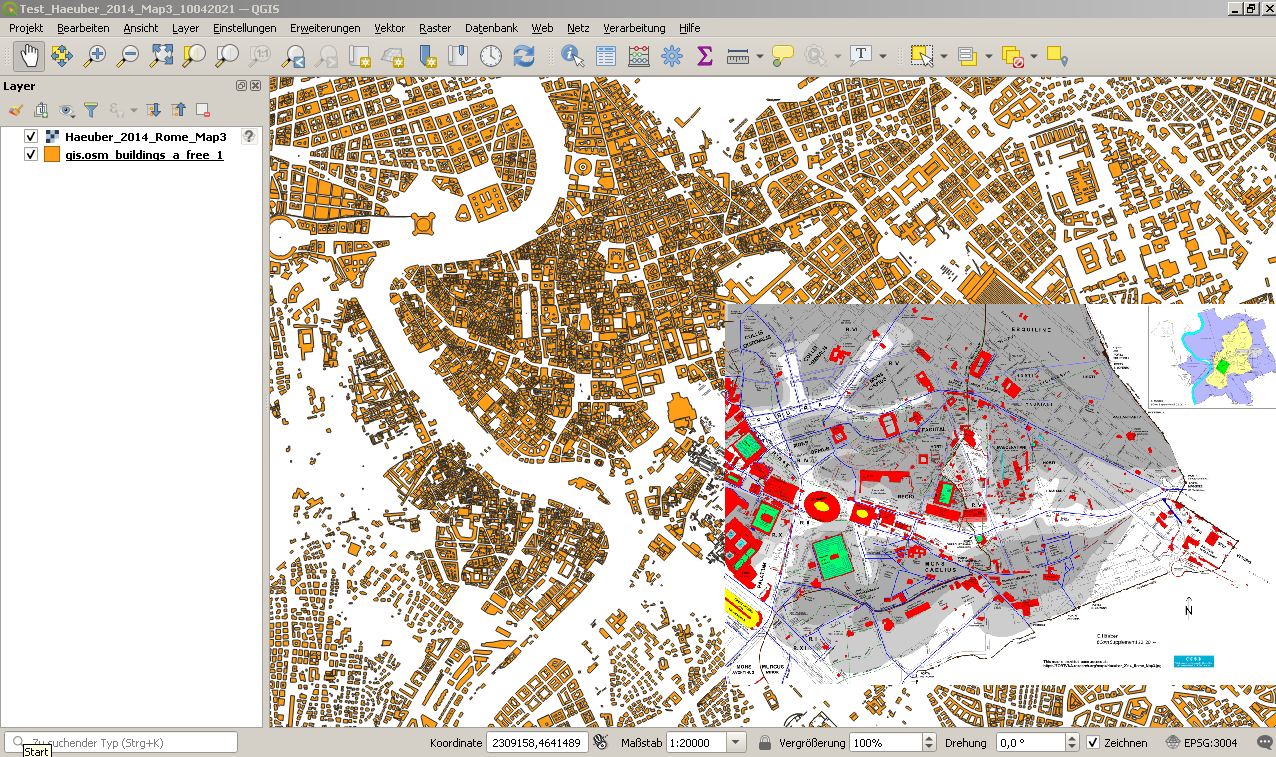
Text zu Map 3 (vgl. HÄUBER 2014, Seiten 873 bis 874):
"Map 3: Diachronic topographical map of Rome comprising the area between the eastern slopes of the Palatine and the Esquiline. It contains also those ancient structures which cannot yet be dated, the post-antique toponymy, and the current street plan.
Only topographical features, which can be certainly located are integrated into this map. Red areas represent ground-plans of ancient buildings, including in some cases churches. Pink areas adjacent to them, and bordered with dotted lines are reconstructed parts of those buildings. Grey areas within the ground-plans of ancient buildings are open air spaces. The adjacent light grey areas, bordered by dotted lines, are reconstructed parts of these open air spaces. The sizes and shapes of the red areas do not represent in all cases the original sizes and shapes of the ground-plans of the ancient structures and buildings in question, because many of these were already heavily destroyed when found or documented, or had occurred in building sites, where it was impossible to document them in their entirety. Excavated sections of the Servian city Wall are drawn as 4 m wide light brown lines, the reconstructed course of the Servian city Wall as 4 m wide dark brown lines. The Aurelianic Walls appear in a different brown shade. Their ground-plan was drawn after the photogrammetric data. Ancient roads are drawn as 3 m wide dark blue lines, and post-antique roads, copied after G.B. Nolli’s Rome map (1748; cf. map 1), as light blue lines, reconstructed ancient roads as dotted green lines, cisterns and water basins as blue areas, and gardens as green areas. Raised areas, by which the plateaus of hills were enlarged, are indicated with a light grey area bordered by a dotted line. The shaded relief was drawn after G.B. Nolli’s Rome map (1748); following recent studies, the relevant cartographic information was at some points corrected.
This map was made with the "AIS ROMA" and is based on the photogrammetric data of the Comune di Roma (now: Roma Capitale). C. Häuber & F.X. Schütz, actual state September 13th, 2013, reconstruction. The photogrammetric data were generously provided by the Sovraintendenza ai Beni Culturali (BB.CC.) of the Comune di Roma (now: Roma Capitale). These data were generated for the "Centro di Documentazione Forma Romae", and are the basis of the project "Nuova Forma Urbis Romae"; cf. chapter Acknowledgements and Introduction, of which C. Häuber and F.X. Schütz are cooperation partners."
"[Inserted box on Map 3:]
Map of archaic Rome within its later city walls,
reconstruction
This map shows archaic landscape features, buildings and roads that are mentioned in the text." cf. HÄUBER (2014, p. 873)
"Most of the represented roads existed already in the archaic period; others, for example the Via Appia, the Via Flaminia and the Via Nomentana were added in order to facilitate orientation; this is also true for the Colosseum and for some churches. The drawing of the archaic roads is based on Coarelli 2003b, p. 9 and Carandini, Carafa 2012, Tavole fuori testo. Quadro di unione, and the drawing of the Via Nomentana on LTUR V, 1999, fig. 89 (drawing: C. Buzzetti, E. Gatti).
For the alleged city Roma quadrata cf. F. Coarelli, in: LTUR IV, 1999, pp. 207-209; Wiseman 2012a, pp. 379-383. It is here drawn as an area bordered with dotted lines because its location is at best very approximative, and between the following four toponyms which have likewise only tentatively been located: the Porta Romana; cf. Pensabene 2007, pp. 340, 343; the Porta Romanula; cf. Hurst 2006, pp. 241-276; Wiseman 2012b; the Curiae Veteres; cf. Panella 1996; ead. 2006, pp. 81-91; Cecamore 2002a, p. 34; ead. 2002b; C.J. Smith 2006, pp. 184, 202-204; the Ara of Consus; cf. P. Ciancio Rossetto, in: LTUR I, 1993, p. 322; Carandini, CARAFA 2012, Tavole fuori testo 25. The location tentatively chosen here for the Ara of Consus is based on the assumption that the Porta Romana and the Curiae Veteres have been correctly located. But note that there is practically no evidence for the location of the alleged Porta Romanula, and that the location of the Curiae Veteres is likewise debated. The resulting area on our map is approximately rectangular, not ‘square’, and also much smaller than the Roma quadrata described in the literary sources.
The ground-plans of the Aurelianic walls, of the wall built by Pope Urban VIII on the Janiculum and of the wall surrounding the Vatican City were drawn after the photogrammetric data; the reconstructed section of the Aurelianic walls on the Janiculum was drawn after its scarce remains; cf. Carandini, Carafa 2012, Tavole fuori testo. Quadro di unione, Tav. 17; 18; 23; 24; 29. The reconstruction of the area covered by the Esquiline burial ground in the archaic period is based on Bartoloni 1987, fig. 5; Carandini, Carafa 2012, Tav. 123 and on my own research. The reconstruction of the Servian city wall is based on LTUR III, 1996, pp. 319-334; Häuber 2005; Carandini, Carafa 2012, Tavole fuori testo 30 and my own further research.
Roma quadrata is indicated as a green area, the city surrounded by the Servian city wall as a yellow area, the city surrounded by the Aurelianic walls as a violet area. The representation of the Tiber is not an attempt to reconstruct its archaic course but was drawn after the photogrammetric data which show the current situation; the bridges have been omitted. C. Häuber & F.X. Schütz, AIS ROMA, actual state September 13th, 2013. The map is based on the photogrammetric data of the Comune di Roma (now: Roma Capitale)." cf. HÄUBER (2014, p. 874).
Datenschutzerklärung | Impressum